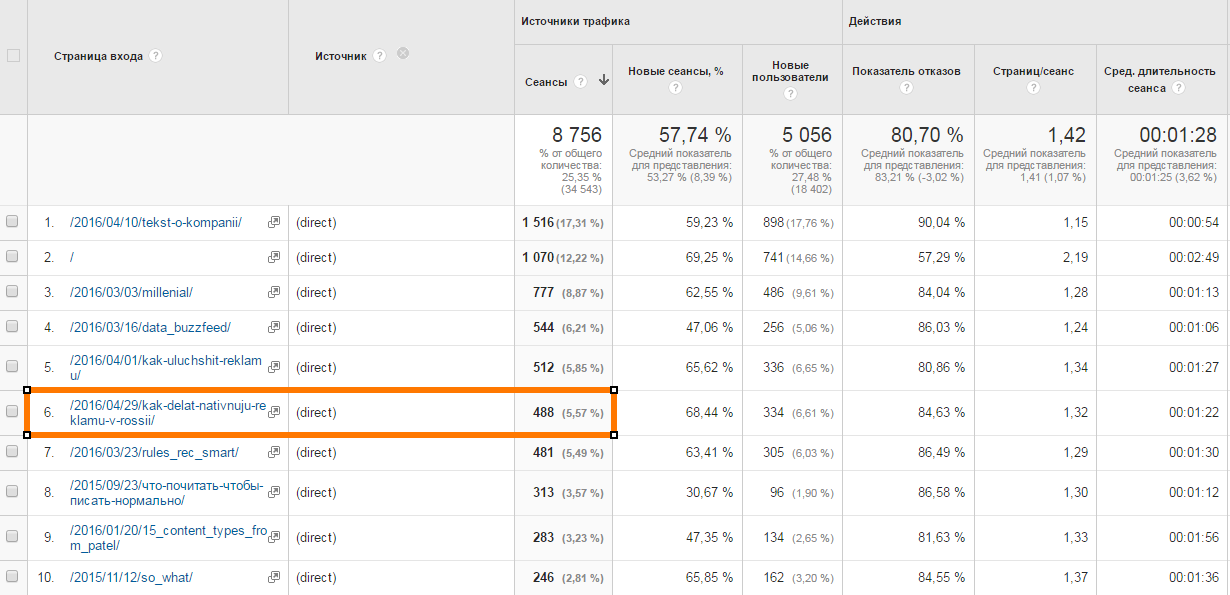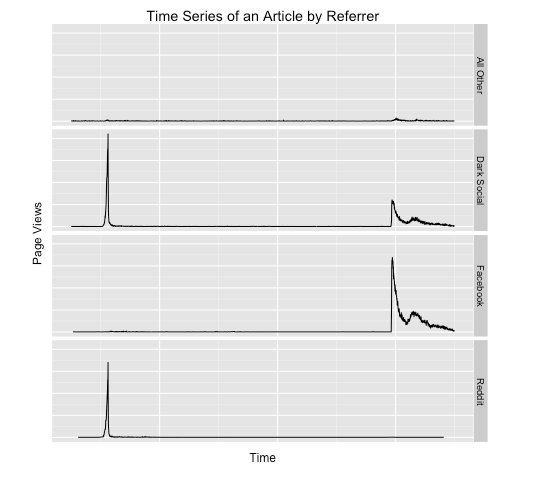What traffic actually comes to Direct, even if you are an honest person

"Dark". And this is despite the fact that your site does not open in an additional tab, you are filtering transitions from Satanist sites and are not catching up visitors to content projects from Volochkova’s boobs.
The term “dark traffic” (dark traffic) refers to the transition to the site where the source of the traffic remains unknown.
')
Back in 2013, the president of one of the leading American publications of The Atlantic, Bob Cohn, admitted that he and his staff have no idea where 25% of readers come to the site. Since then, the number of "dark traffic" has increased markedly among all publishers.
According to estimates by Chartbeat , which specializes in web analytics, this figure last year exceeded one third of the audience of American media. And if we talk about mobile traffic, then there it is approaching half.
Where can “dark traffic” come from and how is it reflected in analytics?
In the overwhelming majority of cases, analytics services display visits from undefined sources in the Direct category. Although initially there were supposed to get only transitions from the "Favorites" and the links entered in the address bar of the browser.
It is difficult to assume that the average user can actually dial manually, for example, here is a link: https://blog.relap.ru/2016/04/29/kak-delat-nativnuju-reklamu-v-rossii/ .
But from direct to this material 488 users came. That is, we cannot say exactly where these 22% of users who looked at the material came from.


In practice, the user clicks on the link in some instant messenger. After that, a new browser tab usually opens, which analytics services count as a direct entry.
Media experts estimate that a large proportion of “dark traffic” comes from Facebook Messenger, Google Hangouts, WhatsApp, Snapchat, Slack, WeChat messengers.
It could also be visitors who copied the link and pasted it directly into the address bar. It also includes transitions from emails or SMS.
Where else can “dark traffic” come from?
- from sites that use encrypted HTTPS data transfer to sites that do not use it,
- from mobile apps, including mobile Facebook and Twitter clients,
- from offline files - text documents, PDF files, presentations that contain links to sites,
- from search results by pictures,
- from search services that do not store user data. Like DuckDuckGo .
The result is that there is a whole environment where users are very actively interacting with content. But publishers have no idea what is happening there.
Why does publishers care?
Publishers have 2 tasks. Bring the user to the site and make it stay there for a long time. Sites with high traffic and high involvement can sell more advertising.
But even to assume where a user comes to your site becomes more difficult every year. Because the number of content distribution channels is very large.

Alexander Kuksa,
Development Director BigPicture.ru
It used to be: I hung it up on the main post, everyone snapped it up, left each other in ICQ - everyone is happy. Now channels an incredible amount. Starting from direct messages in WhatsApp, Telegram, Skype, Facebook personal chat, mail, social networks. In social networks, some kind of public can be picked up, and someone can repost to the wall directly from the site and from there go and go along the chain.
Information about traffic sources gives the editorial board an understanding of the channels in which users find the content of the publication. What channels should be developed, and which can be started to drift. Which users are most loyal? Which media makes more money?
And now it turns out that the most advanced and at the same time simple channels, such as instant messengers and mail, are not displayed objectively in analytics.
How to understand that something is wrong with metrics?

Oleg Borisevich,
marketing director and co-owner of Link-Assistant.Com
The number of actual direct visits to the site usually varies around 10-20% . If this figure is less, you should think about brand awareness. But if this figure is too high, you migrate into the realm of "dark" traffic.
And this means that the data in your analytics are distorted. While the number of direct hits is artificially high, the transitions from email and social media are, on the contrary, underestimated. This is how “dark traffic” works.
Is it possible to do something with this?
The number of tools with which you can somehow identify the "dark traffic" is very limited.
More or less distinct successes in the field of studying the "dark traffic" has made the British Guardian newspaper. She incorporated this feature into her Ophan editorial tool. The essence of the Guardian method is in tracking the life of individual publications. For example, if the article gained popularity on Reddit, and “Reddit” did not appear in the traffic sources, the editors come to the conclusion that the transitions come from one of the mobile applications that is not sharing data.
But even the Guardian, considered the foremost in the fight against "dark traffic", has no idea about the origin of 10-15% of visits to its website.
Some publishers flash UTM tagged links in mailing lists. You can track bursts of mentions of a particular publication in social networks and compare them with the growth of direct traffic.

The chart Chartbeat, which shows how the sharp increase in “dark traffic” (the second column from the top) initially coincides with the surge in the reference to the publication in Reddit, and then with the growth of its popularity on Facebook.
Source: http://uk.businessinsider.com/facebook-mobile-app-responsible-for-dark-traffic-2014-12?r=US&IR=T
How to work with traffic from unknown sources?
If it is not possible to develop the distribution channel outside the site, it is possible to develop distribution channels and process the “dark” traffic inside the site. That is, to offer each user relevant content already when it came to your site.
So that he himself would throw off the links to his friends in the telegraph, facebook messenger or whatever is more convenient for him. And the channels that the publisher cannot control still worked.
Recommended algorithms help to distribute content within the publication so that each user receives the most relevant articles. You can configure several blocks on the site in such a way that they form a complete infrastructure that will allow you to lead the visitor along the most interesting and long way. He will stay on the site longer and look at more pages. As a result, the publisher’s task remains accomplished.
Along with the development of user habits, the “dark” traffic becomes more and more. But “dark” traffic is not necessarily lost.
Source: https://habr.com/ru/post/302528/
All Articles